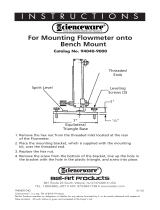
1 About this guide
This guide provides basic guidelines for the Rosemount
™
8800D Series
Vortex Flowmeter. It does not provide instructions for detailed
configuration, diagnostics, maintenance, service, troubleshooting,
Explosion-proof, Flameproof, or Intrinsically Safe (I.S.) installations. Refer to
the reference manual for more instruction. The manuals and this quick start
guide are also available electronically on EmersonProcess.com/Rosemount.
WARNING
Explosions could result in death or serious injury.
Installation of this transmitter in an explosive environment must be in
accordance with the appropriate local, national, and international standards,
codes, and practices. Review the approvals section of thereference manual
for any restrictions associated with a safe installation.
• Before connecting a handheld communicator in an explosive
atmosphere, make sure the instruments in the loop are installed in
accordance with intrinsically safe or non-incendive field wiring practices.
• Verify the operating atmosphere of the flowmeter is consistent with the
appropriate product certifications.
• In an Explosion-proof/Flameproof installation, do not remove the
flowmeter covers when power is applied to the unit. Electrical shock can
result in death or serious injury.
WARNING
Electrical shock can result in death or serious injury.
• Avoid contact with the leads and terminals. High voltage that may be
present on leads can cause electrical shock.
1.1
Return policy
Emerson procedures must be followed when returning equipment. These
procedures ensure legal compliance with government transportation
agencies and help provide a safe working environment for Emerson
employees. Failure to follow Emerson procedures will result in your
equipment being refused delivery.
Quick Start Guide April 2019
2 Rosemount
™
8800D Series Vortex Flowmeter




















